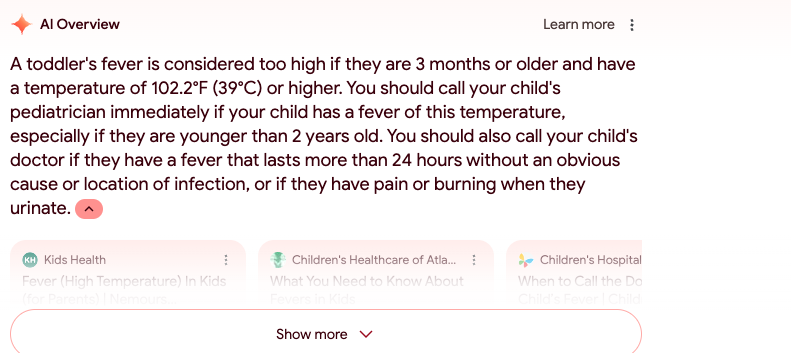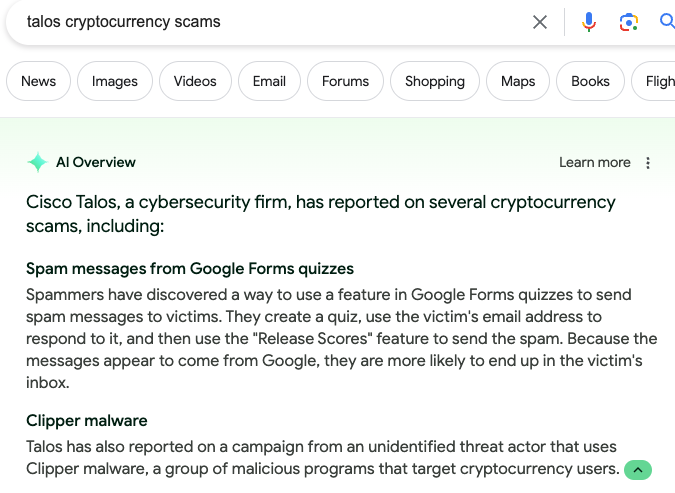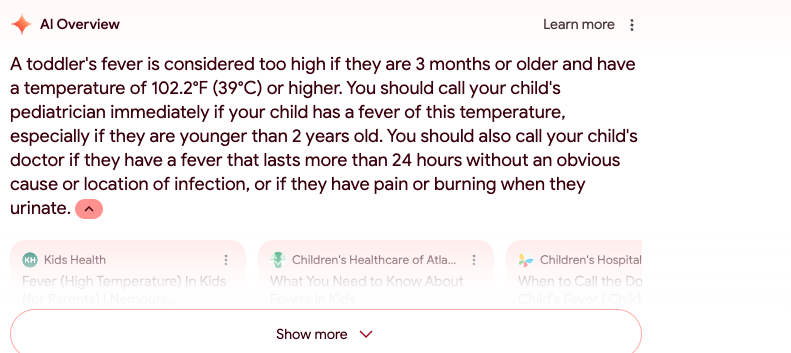As someone who used to think that his entire livelihood would come from writing, I’ve long wondered if any sort of computer or AI could replace my essential functions at work. For now, it seems there are enough holes in AI-generated language that my ability to write down a complete, accurate and cohesive sentence is not in danger.
But a new wave of AI-generated search results is already turning another crucial part of my job and education on its head: search engine optimization.
Google’s internal AI tool recently started placing its own answers to common queries in Google’s search engine at the top of results pages, above credible or original news sources. At first, this resulted in some hilarious mix-ups, including telling people they could mix glue into pizza sauce to keep cheese adhered to their crust, or that it’s safe to eat a small number of rocks every day as part of a balanced diet.
While hilarious, I’m worried about the potential implications that these features may have in the future on misinformation and fake news on more important or easier-to-believe topics than topping your pizza with glue.
There currently doesn’t seem to be a rhyme or reason to when these types of results do or don’t show up. Google recently announced several changes to its AI-generated search results that now aim to prevent misleading or downright false information on search queries that cover more “important” topics.
“For topics like news and health, we already have strong guardrails in place. For example, we aim to not show AI Overviews for hard news topics, where freshness and factuality are important. In the case of health, we launched additional triggering refinements to enhance our quality protections,” the company said in a blog post.
When testing this out firsthand, I got mixed results. For “hard” news topics, they aren’t displaying AI-generated results at all. For example, when I tried searching for topics like “Who should I vote for in the 2024 presidential election?” and “Does the flu vaccine really work?”
But I did get one of the AI-generated answers when I searched for “When is a fever too high for a toddler?” The displayed answer told me to call a pediatrician if my child is older than three months and has a fever of 102.2 degrees Fahrenheit or higher. Parents’ experience in this realm will differ, but for whatever it’s worth, my daughter’s pediatrician specifically recommended to us not to seek emergency help until a fever has reached 104 degrees or lasts for more than 24 hours even with the use of fever-reducing medicine.

Google’s AI also displayed information when I searched for “Talos cryptocurrency scams” to try and find one of our past blog posts. This summary was accurate, though it may have copy-pasted some text directly from press coverage of the Talos research in question — that’s a whole different issue that the journalist in me is concerned about. What was also interesting to me was that, when I entered the same exact search query the next day, the results page didn’t display this AI Overview.

Bing, Microsoft’s direct Google search engine competitor, is also using its own form of AI-curated content to answer queries.
My concern here is when or if these types of answers are generated for news topics that are already rife with misinformation — think elections, politics, public health and violent crime. Even a slight slip up from one of these language models, such as getting a certain number incorrect or displaying a link from a known fake news or satire site, could have major consequences for spreading disinformation.
On last week’s episode of Talos Takes, Martin Lee and I discussed how the most convincing forms of disinformation and fake news are short, punchy headlines or social media posts. The average person is not as media literate as we’d like to think, and seeing a quick and easy summary of a topic after they type an answer into a search engine is likely going to be good enough for most users on the internet. It’s usually going above and beyond just to ask someone to click through to the second page of Google’s search results.
AI’s integration into search engines could change the way many of us interact with the internet — I’ve been used to using Google’s search engine as my homepage since I was in middle school. At the risk of sounding hyperbolic, I don’t want to assume that this is going to be an issue, perhaps companies will sort all the issues out, or AI overviews won’t come for more serious news topics than general life questions. But so far, the results shouldn’t inspire much confidence.
The one big thing
Cisco Talos recently discovered a new threat actor called “LilacSquid” targeting the IT and pharmacy sectors, looking to maintain persistent access on victim’s networks. This campaign leverages vulnerabilities in public-facing application servers and compromised remote desktop protocol (RDP) credentials to orchestrate the deployment of a variety of open-source tools, such as MeshAgent and SSF, alongside customized malware, such as "PurpleInk," and two malware loaders we are calling "InkBox" and "InkLoader.”
Why do I care?
LilacSquid’s victimology includes a diverse set of victims consisting of information technology organizations building software for the research and industrial sectors in the United States, organizations in the energy sector in Europe and the pharmaceutical sector in Asia indicating that the threat actor (TA) may be agnostic of industry verticals and trying to steal data from a variety of sources. Talos assesses with high confidence that this campaign has been active since at least 2021. Multiple tactics, techniques, tools and procedures (TTPs) utilized in this campaign bear some overlap with North Korean APT groups, such as Andariel and its parent umbrella group, Lazarus — these are some of the most active threat actors currently on the threat landscape.
So now what?
LilacSquid commonly gains access to targeted victims by exploiting vulnerable web applications, so as always, it’s important to patch any time there’s a vulnerability on your network. Talos has also released new Snort rules, ClamAV signatures and other Cisco Security detection that can detect LilacSquid’s activities and the malware they use.
Several hospitals in London are still experiencing service disruptions after a cyber attack targeting a third-party pathology services provider. Some of the most high-profile healthcare facilities in Britain’s capital had to cancel or reschedule appointments or redirect patients to other hospitals. Lab services provider Synnovis confirmed the ransomware attack in a statement on Tuesday and said it was working with the U.K.’s National Health Service to minimize the effects on patients. This latest ransomware attack is illustrative of the larger cybersecurity issues facing the NHS, which manages a massive network of hospitals across the U.K. and has more than 1.7 million employees. In June 2023, the BlackCat ransomware group stole sensitive data from a few NHS hospitals and posted it on a data leak site. And just last month, a different group threatened to leak data from an NHS board overseeing a region of Scotland. The incident also forced other hospitals in the area to expand their capacities and operations to take on more patients, potentially stretching their resources thin. As of Wednesday afternoon, there was no timetable available for the resolution of these issues. (The Record by Recorded Future, Bloomberg)
International law enforcement agencies teamed up for what they are calling one of the largest botnet disruptions ever. U.S. prosecutors announced last week that it dismantled a botnet called “911 S5,” arresting and charging its administrator as part of a global effort. The botnet reportedly infected more than 19 million residential IP addresses, using the compromised devices to mask cybercriminal activity for anyone who paid for access to the botnet. Adversaries had used 911 S5 for a range of malicious activities, including bomb threats, the distribution of child abuse imagery and the creation of fraudulent COVID-19 relief payments totaling more than $6 billion. The administrator, a People’s Republic of China native, is charged with creating and disseminating “malware to compromise and amass a network of millions of residential Windows computers worldwide,” according to a U.S. Department of Justice press release. The botnet was allegedly active between 2014 and July 2022. 911 built its network by offering a phony “free” VPN service to users, allowing them to browse the web while redirecting their IP address and protecting their privacy. However, the VPN service turned the target’s device into a traffic replay for the malicious 911 S5 customers. (U.S. Department of Justice, Krebs on Security)
In a separate law enforcement campaign called “Operation Endgame,” law enforcement agencies from several countries disrupted droppers belonging to several malware families. Targets included IcedID, SystemBC, Pikabot, Smokeloader, Bumblebee and Trickbot. The coordinated effort between multiple European countries and the U.S. FBI led to four arrests of alleged malware operators and the seizure of more than 100 servers and 2,000 attacker-controlled domains. Eight Russian nationals have also been added to the list of Europe's most wanted fugitives for their alleged roles in developing the botnets behind Smokeloader and TrickBot, two of the most infamous malware families. Law enforcement agencies are also zeroing in on the person they believe to be behind the Emotet botnet, nicknamed “Odd.” "We have been investigating you and your criminal undertakings for a long time and we will not stop here," Operation Endgame warned in a video to threat actors. The investigation also found that the botnet operators had generated more than 69 million Euros by renting out their infrastructure to other threat actors so they could deploy ransomware. (Dark Reading, Europol)
- Talos Takes Ep. #185: How much has AI helped bad actors who spread disinformation?
- DarkGate switches up its tactics with new payload, email templates
- New banking trojan “CarnavalHeist” targets Brazil with overlay attacks
- New Nork-ish cyberespionage outfit uncovered after three years
- LilacSquid APT Employs Open Source Tools, QuasarRAT
- NHS cyber attack causes cancellations as London hospitals hit by ‘major IT incident’
AREA41 (June 6 – 7)
Zurich, Switzerland
Gergana Karadzhova-Dangela from Cisco Talos Incident Response will highlight the primordial importance of actionable incident response documentation for the overall response readiness of an organization. During this talk, she will share commonly observed mistakes when writing IR documentation and ways to avoid them. She will draw on her experiences as a responder who works with customers during proactive activities and actual cybersecurity breaches.
Cisco Connect U.K. (June 25)
London, England
In a fireside chat, Cisco Talos experts Martin Lee and Hazel Burton discuss the most prominent cybersecurity threat trends of the near future, how these are likely to impact UK organizations in the coming years, and what steps we need to take to keep safe.
BlackHat USA (Aug. 3 – 8)
Las Vegas, Nevada
Defcon (Aug. 8 – 11)
Las Vegas, Nevada
BSides Krakow (Sept. 14)
Krakow, Poland
Most prevalent malware files from Talos telemetry over the past week
SHA 256: 9be2103d3418d266de57143c2164b31c27dfa73c22e42137f3fe63a21f793202
MD5: e4acf0e303e9f1371f029e013f902262
Typical Filename: FileZilla_3.67.0_win64_sponsored2-setup.exe
Claimed Product: FileZilla
Detection Name: W32.Application.27hg.1201
SHA 256: 0e2263d4f239a5c39960ffa6b6b688faa7fc3075e130fe0d4599d5b95ef20647
MD5: bbcf7a68f4164a9f5f5cb2d9f30d9790
Typical Filename: bbcf7a68f4164a9f5f5cb2d9f30d9790.vir
Claimed Product: N/A
Detection Name: Win.Dropper.Scar::1201
SHA 256: 5616b94f1a40b49096e2f8f78d646891b45c649473a5b67b8beddac46ad398e1
MD5: 3e10a74a7613d1cae4b9749d7ec93515
Typical Filename: IMG001.exe
Claimed Product: N/A
Detection Name: Win.Dropper.Coinminer::1201
SHA 256: a024a18e27707738adcd7b5a740c5a93534b4b8c9d3b947f6d85740af19d17d0
MD5: b4440eea7367c3fb04a89225df4022a6
Typical Filename: Pdfixers.exe
Claimed Product: Pdfixers
Detection Name: W32.Superfluss:PUPgenPUP.27gq.1201
SHA 256: c67b03c0a91eaefffd2f2c79b5c26a2648b8d3c19a22cadf35453455ff08ead0
MD5: 8c69830a50fb85d8a794fa46643493b2
Typical Filename: AAct.exe
Claimed Product: N/A
Detection Name: PUA.Win.Dropper.Generic::1201
